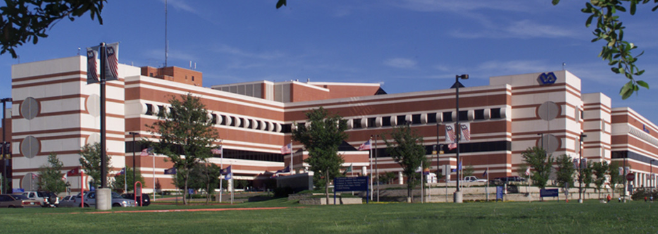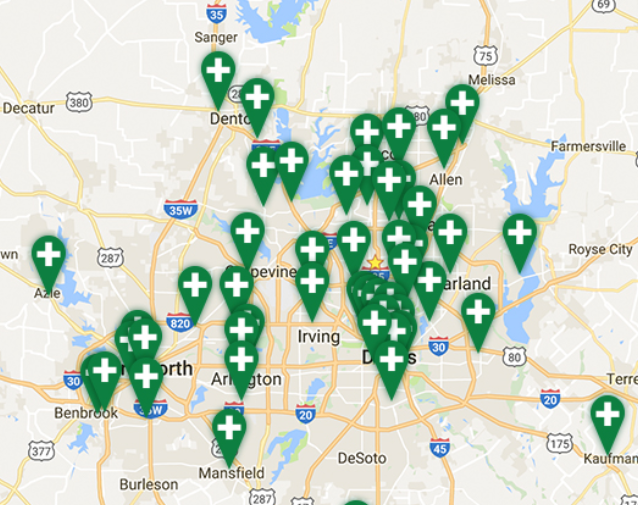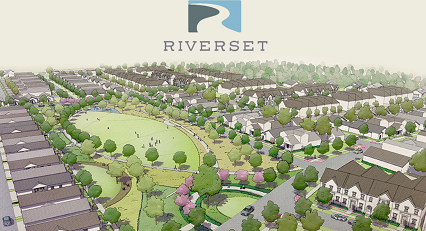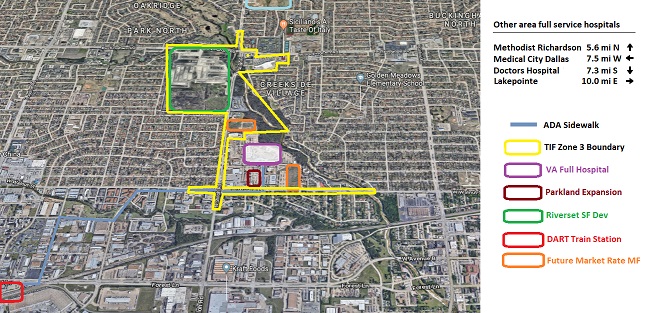
(Due to demand, here’s a downloadable PDF version of this article)
24 months ago, during the spring of 2017 we heard the news that Baylor Garland was looking to sell but would stick around until they had a new owner.
18 months ago, we were told that Baylor was going to close its doors.
12 months ago, as Baylor was closing its doors, they reaffirmed their commitment to the Hope Clinic.
9 months ago, they mostly abandoned the Hope Clinic.
As of February 2019, Garland Behavioral Health occupies part of the old main building, and the plazas are sparsely populated. The area bank is moving to a better location in downtown, and the surrounding businesses are struggling.
We’ve been told that even with the TIF, the medical district overlay, and a strong will to succeed, we were looking at ten years for that area of the city to recover from the loss of Baylor. That was not an acceptable timeline to your city’s leadership.
In December of 2017, I told you via my blog that the city was serious about having medical services in the community and I gave you my word that we weren’t going down without a fight. While that fight isn’t over, today marks a huge milestone in our efforts to deliver on that promise.
We haven’t been quiet. We’ve been relentless in our pursuit of a solution. And today, one year later, we have results and the beginning of something big. There are five major elements to getting this area back on track.
The Main Campus
While no official statement has been made by the VA, Baylor Scott & White, or the City of Garland, a news report released this week confirms what has been widely speculated.
The Veteran’s Administration is in the process of completing an agreement to acquire the Baylor Hospital campus at Walnut and Shiloh. This means several things to us as a community.
We have roughly 20,000 veterans in a 10-mile radius that utilize the VA’s health services. Most have to travel to Lancaster / South Dallas for treatment. This is usually an all-day affair for those living in Garland. Many of our vets are stuck on mass transit for an hour each way just to have a basic primary care visit. The VA acknowledges that Garland is one of the fastest growing service areas in the country, with some of the greatest shortages in service availability.
Due to federal security requirements, the VA site will not be open to the public in that their grounds will be secured. However, there will be a patient intake area, federal security forces, and most importantly federal regulations on the condition in which the building is maintained. Their ambulance service will be private/contract, so there will be no additional strain on our EMS services. Their facility will also respond to mass casualty scenarios, such as the 2015 tornado.
“Okay great Robert, but where does that leave the rest of us that can’t take advantage of the VA?”
That answer is complex. To answer that, we look at exactly what was lost when Baylor went away.
• E.R. / ICU
• Primary Care
• Cath Lab
• General surgery center
• The anchor for all of the plazas / economic activity
• Support for the Hope Clinic
• 800 jobs
• Indigent care
• Support for 10,500 non-emergency ER visits per year (2017 numbers)
We did not lose the ability to treat trauma cases- Baylor was never equipped to handle them to begin with. We also did not lose obstetrics, as Baylor had closed down that service several years prior to their full closure as well.
So here’s what we gain with the VA presence:
• A ‘critical case’ ER that by law must at least stabilize a patient prior to transport – this would include catheterization for heart attacks
• An anchor for private services in the plaza
• Increased economic activity
• 1200-3500 jobs (max growth projection over 10 years)
• A need for higher end housing to support those employees
• A long term, financially stable employer
• Increased security in the area, especially in and around the creek
• A mass casualty response partner
Since primary care can easily exist in small standalone offices, what do we still lack?
• Indigent care
• General surgery center
• Support for Hope Clinic
• Dedicated Emergency Room
• Support for 10,500 non-emergency ER visits per year (2017 numbers)
So next we looked to tackle that list.
The Plazas and Indigent Care
Since last fall the City of Garland, City Council, Dallas County HHS, Commissioner Daniel, Parkland, Hope Clinic, and various other agencies within the county have met on a monthly basis to figure out the next piece of this puzzle.
Parkland currently has an operation at the Carver Center in east Garland which has a variety of services. They have recently signed agreements with the building owner and with the city to move half of these services to Plaza 3 just southwest of the new VA campus. They then intend to double the size of the new team and the team that is still at Carver. The upshot of this is that they will keep adult and geriatric services at Carver, with expanded weekend hours, and double the staff. They will move their prenatal and pediatric care over to Plaza 3 and double the size of the current team.
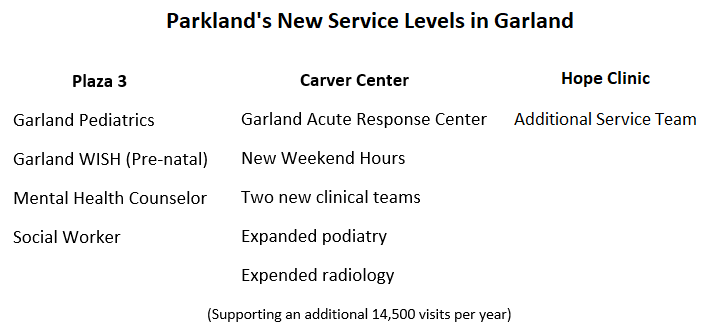
Why is this important, and how is a Parkland presence helpful? To answer that we have to look at why Baylor Garland closed to begin with. When > 40% of your patients are uninsured, and 25% of them never pay a dime of their bill, then you can’t be successful. Some facility MUST be available to absorb that loss. And since we as Garland taxpayers send ~ $30m a year to the Parkland system, we have to demand service for that contribution.
To their credit, Parkland’s senior management was receptive, professional, and has made good faith efforts at every stage to do right by our community. This new agreement and the expanded services hours are a testament to that effort. They have my sincerest gratitude not only for the result, but how we went about getting there. At the end of the day we will have a facility that can help take the financial pressure not only off of the private hospital services that want to come in and succeed, but also serve the two poorest census tracts in the city.
Additionally, they are contributing staff and materials to the Hope Clinic. Between Parkland’s contribution and ongoing support from Methodist Richardson, the Hope Clinic will be in great shape to continue their ongoing commitment to the community.
This leaves us with two remaining issues:
1) General Surgery Center
2) Dedicated ER
Perceived Loss
When you look at the city of Garland, we are in the middle of one of the most heavily served populations in the world when it comes to quality medical care.
We have four, full service general hospitals within 10 miles of the old Baylor site:
– Methodist Richardson, 5.6mi North
– Medical City Dallas, 7.5mi West
– Doctors/City Hospital, 7.3mi South
– Lakepointe (BS&W), 10mi East
As I’ve looked back on my own past medical history, I’ve realized that I’ve had surgery at Medical City Dallas, Presbyterian Plano, and Medical City McKinney- all while living in my home in Garland. And thanks to our strong network of roads and freeways, it is relatively easy to get to a surgical center. When Baylor closed, many of the surgeons found work in local area hospitals, and still serve Garland.
So when we hear the phrase “we’re a city of 234,000 people without a hospital”, we know that isn’t entirely accurate. Perhaps there isn’t a full service hospital that sits within the city’s political boundaries, but we have four hospitals that sit on the perimeter of the city and serve our residents today.
In this case, the perceived loss is the problem as opposed to the actual loss. While we experience minor inconveniences in increased travel times for scheduled medical services, our actual “loss” really boils down to the how we handle the unscheduled trips. We lack a dedicated E.R.
An Emergency Room
This is the one item that I have no answer for today. I believe we should have a place near the city center that can handle things like broken bones, abdominal pain, allergic reactions, etc. With many of these, timing is important. It is my hope that we can still find a place within the campus to operate a standalone E.R. that is run by a reputable group with very clear insurance policies. While Urgent Care clinics are numerous and convenient within the city, not all emergency issues can be handled by those facilities.
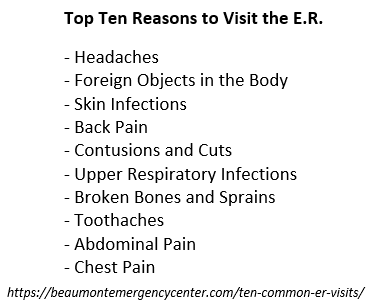
While we continue the search for an E.R. partner, we have to keep working on the effectiveness of what we have in place today. We will continue to optimize traffic to make travel time as fast as possible to each of the four perimeter hospitals. We will also continue our increased EMS staff and ambulance count to guarantee speed and availability of transport service. DART is also acting as a partner by watching rider counts very closely. They are working consistently to guarantee services to each of the hospitals in its service area. The city of Dallas has begun rolling out its own traffic signal pre-emption devices, guaranteeing that EMS can reach their destinations more quickly. I’ve worked with their Director of Transportation to prioritize Garland’s access to Doctors Hospital and Medical City during their rollout.
We are by no means done working on bringing providers to the campus, and I will continue to pursue options such as standalone E.R.s and micro-hospitals. For now we’ll continue to optimize what we have and lay the groundwork for the next generation of care.
Housing and Local Economy
One reason that Baylor suffered financially is because the demographic group that used the E.R. was largely self-pay (no pay). There is so much that is outside of the city’s control when it comes to healthcare and insurance that it is hard for us to make meaningful progress on the issue. However, one thing that does land in our area of responsibility is the strength of the local economy with housing and jobs.
Housing
Several years ago, the city council approved the Wilbow/Riverset development at the corner of Buckingham and Shiloh. It was partly an effort at bringing higher quality housing to an older section of the city, but it was also intended to be used to house the staff at Baylor. Many hospitals have requirements for doctors to live within a certain distance of the hospital for on-call reasons. Baylor began having recruitment issues due to our lower quality of housing stock in that area.
I anticipate that Riverset will find many buyers that are also full-time staff at the new VA center.
In the past two years, I have chosen to reject a sub-market rate multi-family development at the corner of Clara Barton and Walnut due to uncertainty about the future of the area. I supported a senior living center just southeast of the Episcopal church, which did not win an award from the state. I am happy to report that due to the use of the VA system as a physician training system (2/3’s of the United States’ physicians are trained within the VA), we will have a need for high end, market rate multifamily in those two locations. I’m working with the landowners and their developers on their projects continually.
It is my hope that higher end multifamily adjacent to the old 1960’s apartment stock we have on Walnut will place market pressure on those properties to perform better and bring up the housing quality of the entire neighborhood.
Economy
A philosophy of economic development that I hold to is that it is more productive to invest in your infrastructure and become the type of area that businesses want to come to rather than incentivize businesses directly. To that end, I championed a Tax Increment Finance district for this area. The council approved ‘TIF 3’ in 2018. The purpose of a TIF is to capture increases in property tax revenue in a particular area, then reinvest those dollars back within that area. Some cities use the money as handouts to businesses. I prefer direct investment in the infrastructure.
I think that we all realize how far the infrastructure in the TIF area has fallen, and that it does need additional work. Shiloh Rd has the drivability of a mine field. Lighting is poor. Landscaping is non-existent. We have drainage issues. The entire area looks like a concrete jungle from the 1980’s. We can do better. We can work on long-term assets like roads, lighting, and drainage which are long term, positive assets for the city and give taxpayers within the TIF boundary a direct return on their investment.
Economy and mobility are directly related to each other. If you can’t get to a business, you can’t engage in commerce. If you have problems reaching the hospital, or the ride home from surgery jars your new stitches loose you will probably opt to visit a different hospital. On the main area map below you can see that we’re working to improve pedestrian access from the south. We have Shiloh Rd repairs scheduled for 2019/2020. We’re also working on rerouting roads and improving drainage within the main campus area. GP&L continues its work on replacing street lighting and should be completely through in the TIF area by 2020.
We are committed to improving the function and quality of this section of the city through better economy, recreation, education, infrastructure, and healthcare services.
Conclusions
When Baylor Garland left, it exposed two major flaws within the city. The first is that our local economy was weak enough that not only did Baylor have to pull out, but we could not find another private operator to take their place. The second was the enormous amount of pressure it created on our emergency services, showing that we were vulnerable to the loss of a single medical facility.
To fix the first problem, the city had to take meaningful steps to reinvest in the area. That process is underway. Fixing the second issue required creativity by our Fire Department, city management, transportation department, mass transit services, and area hospitals.
If we’ve learned anything, it’s that we need a strong diversity of medical services that are not concentrated in one building or from a single provider. As a city we have to:
– Be proactive in our partnerships with healthcare providers
– Continually keep our infrastructure at a level where businesses have a reasonable chance of success
– Adjust our services based on the demographics of today, not those of forty years ago
– Follow along with changes in the healthcare industry and be prepared to adapt
Otherwise we will find ourselves in this position again somewhere down the road.
This post caps two long years of work on our healthcare issue. My thanks go out to the many, many people that have worked tirelessly on every facet of this issue, and have remained focused on bringing strong healthcare services back to Garland’s core. I would specifically like to thank Dallas County Commissioner Dr Theresa Daniel for her constant support of the City of Garland, City Manager Bryan Bradford, the Garland City Council, the many people that have donated their time and money to the Hope Clinic, those of you who have sat up with me late at night tossing ideas back and forth, the people in the Garland Facebook group that always make us want to work harder, and lastly to all of the citizens of Garland for their passion and involvement on this issue.
